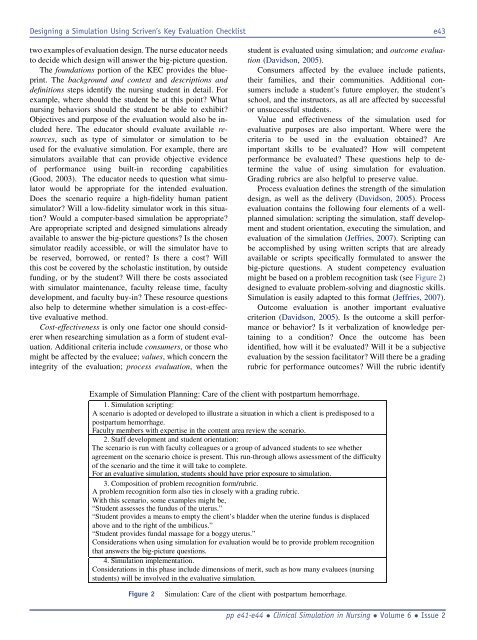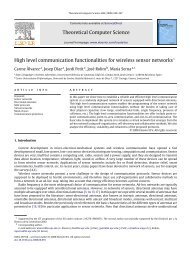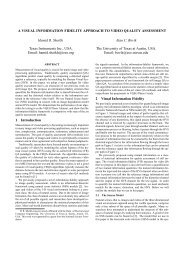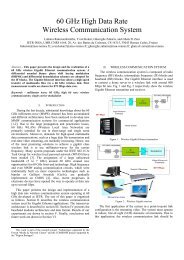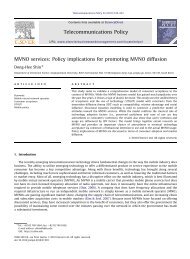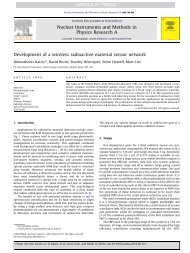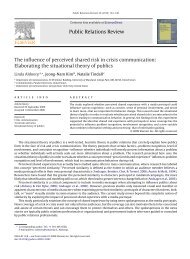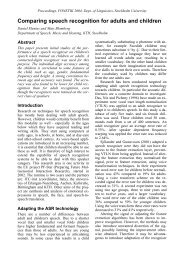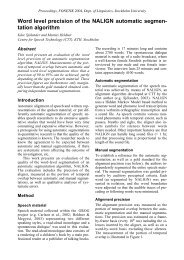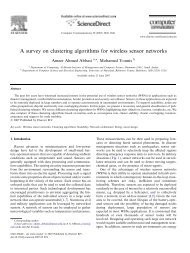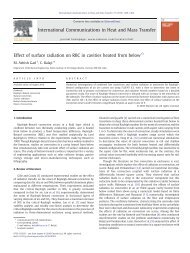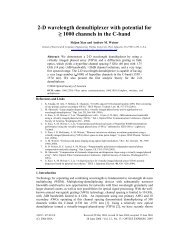Designing a Simulation for Student Evaluation Using Scriven's Key ...
Designing a Simulation for Student Evaluation Using Scriven's Key ...
Designing a Simulation for Student Evaluation Using Scriven's Key ...
You also want an ePaper? Increase the reach of your titles
YUMPU automatically turns print PDFs into web optimized ePapers that Google loves.
<strong>Designing</strong> a <strong>Simulation</strong> <strong>Using</strong> Scriven’s <strong>Key</strong> <strong>Evaluation</strong> Checklist e43<br />
two examples of evaluation design. The nurse educator needs<br />
to decide which design will answer the big-picture question.<br />
The foundations portion of the KEC provides the blueprint.<br />
The background and context and descriptions and<br />
definitions steps identify the nursing student in detail. For<br />
example, where should the student be at this point? What<br />
nursing behaviors should the student be able to exhibit?<br />
Objectives and purpose of the evaluation would also be included<br />
here. The educator should evaluate available resources,<br />
such as type of simulator or simulation to be<br />
used <strong>for</strong> the evaluative simulation. For example, there are<br />
simulators available that can provide objective evidence<br />
of per<strong>for</strong>mance using built-in recording capabilities<br />
(Good, 2003). The educator needs to question what simulator<br />
would be appropriate <strong>for</strong> the intended evaluation.<br />
Does the scenario require a high-fidelity human patient<br />
simulator? Will a low-fidelity simulator work in this situation?<br />
Would a computer-based simulation be appropriate?<br />
Are appropriate scripted and designed simulations already<br />
available to answer the big-picture questions? Is the chosen<br />
simulator readily accessible, or will the simulator have to<br />
be reserved, borrowed, or rented? Is there a cost? Will<br />
this cost be covered by the scholastic institution, by outside<br />
funding, or by the student? Will there be costs associated<br />
with simulator maintenance, faculty release time, faculty<br />
development, and faculty buy-in? These resource questions<br />
also help to determine whether simulation is a cost-effective<br />
evaluative method.<br />
Cost-effectiveness is only one factor one should considerer<br />
when researching simulation as a <strong>for</strong>m of student evaluation.<br />
Additional criteria include consumers, or those who<br />
might be affected by the evaluee; values, which concern the<br />
integrity of the evaluation; process evaluation, when the<br />
student is evaluated using simulation; and outcome evaluation<br />
(Davidson, 2005).<br />
Consumers affected by the evaluee include patients,<br />
their families, and their communities. Additional consumers<br />
include a student’s future employer, the student’s<br />
school, and the instructors, as all are affected by successful<br />
or unsuccessful students.<br />
Value and effectiveness of the simulation used <strong>for</strong><br />
evaluative purposes are also important. Where were the<br />
criteria to be used in the evaluation obtained? Are<br />
important skills to be evaluated? How will competent<br />
per<strong>for</strong>mance be evaluated? These questions help to determine<br />
the value of using simulation <strong>for</strong> evaluation.<br />
Grading rubrics are also helpful to preserve value.<br />
Process evaluation defines the strength of the simulation<br />
design, as well as the delivery (Davidson, 2005). Process<br />
evaluation contains the following four elements of a wellplanned<br />
simulation: scripting the simulation, staff development<br />
and student orientation, executing the simulation, and<br />
evaluation of the simulation (Jeffries, 2007). Scripting can<br />
be accomplished by using written scripts that are already<br />
available or scripts specifically <strong>for</strong>mulated to answer the<br />
big-picture questions. A student competency evaluation<br />
might be based on a problem recognition task (see Figure 2)<br />
designed to evaluate problem-solving and diagnostic skills.<br />
<strong>Simulation</strong> is easily adapted to this <strong>for</strong>mat (Jeffries, 2007).<br />
Outcome evaluation is another important evaluative<br />
criterion (Davidson, 2005). Is the outcome a skill per<strong>for</strong>mance<br />
or behavior? Is it verbalization of knowledge pertaining<br />
to a condition? Once the outcome has been<br />
identified, how will it be evaluated? Will it be a subjective<br />
evaluation by the session facilitator? Will there be a grading<br />
rubric <strong>for</strong> per<strong>for</strong>mance outcomes? Will the rubric identify<br />
Example of <strong>Simulation</strong> Planning: Care of the client with postpartum hemorrhage.<br />
1. <strong>Simulation</strong> scripting:<br />
A scenario is adopted or developed to illustrate a situation in which a client is predisposed to a<br />
postpartum hemorrhage.<br />
Faculty members with expertise in the content area review the scenario.<br />
2. Staff development and student orientation:<br />
The scenario is run with faculty colleagues or a group of advanced students to see whether<br />
agreement on the scenario choice is present. This run-through allows assessment of the difficulty<br />
of the scenario and the time it will take to complete.<br />
For an evaluative simulation, students should have prior exposure to simulation.<br />
3. Composition of problem recognition <strong>for</strong>m/rubric.<br />
A problem recognition <strong>for</strong>m also ties in closely with a grading rubric.<br />
With this scenario, some examples might be,<br />
“<strong>Student</strong> assesses the fundus of the uterus.”<br />
“<strong>Student</strong> provides a means to empty the client’s bladder when the uterine fundus is displaced<br />
above and to the right of the umbilicus.”<br />
“<strong>Student</strong> provides fundal massage <strong>for</strong> a boggy uterus.”<br />
Considerations when using simulation <strong>for</strong> evaluation would be to provide problem recognition<br />
that answers the big-picture questions.<br />
4. <strong>Simulation</strong> implementation.<br />
Considerations in this phase include dimensions of merit, such as how many evaluees (nursing<br />
students) will be involved in the evaluative simulation.<br />
Figure 2 <strong>Simulation</strong>: Care of the client with postpartum hemorrhage.<br />
pp e41-e44 Clinical <strong>Simulation</strong> in Nursing Volume 6 Issue 2


